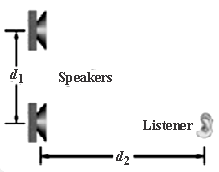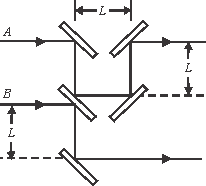Two speakers separated by distance are in phase. Assume the amplitudes of the sound waves from the speakers are approximately the same at the listener's ear at distance directly in front of one speaker. Consider the full audible range for normal hearing. to .

(a) What is the lowest frequency that gives the minimum signal (destructive interference) at the listener's ear?
By what number must be multiplied to get
(b) the second lowest frequency that gives the minimum signal
(c) the third lowest frequency that gives the minimum signal?
(d) what is the lowest frequency that gives the maximum signal (constructive interference) at the listener's ear?
By what number must be multiplied to get
(e) the second lowest frequency that gives the maximum signal and
(f) the third lowest frequency that gives the maximum signal?


Important Questions on Waves-II
Consider two sound waves and , both of wavelength . They are initially in phase and travelling rightward, as indicated by the two rays. is reflected from four surfaces, but ends up travelling in its original direction. Wave ends in that direction after reflecting from two surfaces. Let the distance in the figure be expressed as a multiple of , . What are
the smallest and
the third smallest values of that put and exactly out of phase with each other after the reflections ?

A girl is sitting near the open window of a train that is moving at a velocity of towards the east. The girl's uncle stands near the track and watches the train move away. The locomotive whistle emits sound at frequency . The air is still
What frequency does the uncle hear?
What frequency does the girl hear?
A wind begins to blow from the east at
What frequency does the uncle now hear?
What frequency does the girl now hear?
One clue used by your brain to determine the direction of a source of sound is the time delay between the arrival of the sound at the farther ear. Assume that sources are distant so that a wavefront from it is approximately planar when it reaches you, and let represent the separation between your ears.
If the sources are isolated at angle in front of you, what is in terms of and the speed of sound in the air?
If you are submerged in water and the sound sources are directly to your right, what is in terms of and the speed of sound in water?
Based on the time-delay clue, your brain interprets the submerged sound to arrive at an angle from the forward direction. Evaluate for water at . Assume the speed of sound in air at is and the speed of sound in water at is
A small loudspeaker is driven by an audio oscillator with a frequency that is varied from to , and is a cylindrical pipe with two open ends and a length of .The speed of sound in the air-filled pipe is
At how many frequencies does the sound from the loudspeaker set up a resonance in the pipe?
What are the
Lowest and
Second-lowest frequencies at which resonance occurs?

The pressure in a travelling sound wave is given by the equation
Find the
Pressure amplitude,
Frequency,
Wavelength, and
Speed of the wave.
A column of soldiers, marching at , keep in steps with the beat of a drummer at the head of the column. The soldiers in the rear end of the column are striding forward with the left foot when the drummer is advancing with the right foot. What is the approximate length of the column ?
In a pipe , the ratio of a particular harmonic frequency to the next lower harmonic frequency is . In another pipe , the ratio of a particular harmonic frequency to the next lower harmonic frequency is . How many open ends are in
pipe and
pipe ?
